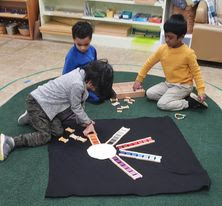Many adults float through life swept by the flow,
reacting to things as they come, and not planning or taking active control or
responsibility for what is going on. They struggle with organizing and
planning. They might get pulled in multiple directions by distractions. They might like to blame
circumstances or others for their lives. While no one can completely
control things around themselves, we can choose to be active and conscious
participants.
In Montessori we believe that
self-control is not an inborn trait but rather a skill we develop over time
with the right circumstances. As parents it is our responsibility to help our
children develop self-control in order to become successful and contributing
members of adult society one day. Children who lack control often suffer many
issues at school and in life - ranging from more disciplinary actions taken
against them, more conflict and trouble with social relationships and poorer
academic outcomes.
So, what can we do to promote developing self-control
and will power?
1. Predictability.
First children need predictability at home - a
reliable schedule so they can predict when things will happen, especially so they know that their
most basic human needs such as eating, sleeping, playing, bathing etc will
happen. This includes bonding and positive emotional time with family as well.
This isn't meant to be rigid but regular enough to develop a sense of trust in
the adults and situation. When the external world is reliably under control then it is easier for the
inner world to be in control, too.
2. Independence.
Children need support in developing independence. This
is key to mental health. When parents thwart the growth of age-appropriate
independence then tantrums are sure to follow. Maria Montessori is known for
having said that we should never do for a child what he/she can successfully do
on his/her own. Yes, we must teach the foundational skills but as the child
progresses then we begin to step back. This is a lifelong process through each
developmental stage of life. Children gain confidence in themselves as well as
many useful skills they can offer back to others. Yes, children may struggle
but through that struggle they train new muscles of resilience and tenacity.
They begin to develop will-power.
3. Discipline/Accountability.
Children need guidance on what is acceptable and what
isn't. They need to be held accountable for their actions and not be given too
much freedom that they aren't ready to handle. Children need boundaries and
limits. Of course, these are enforced in as kind a way as we can but all
parents must be willing to say no to their child and stick to that answer. It
can be one of the hardest parts of parenting but it is necessary for our child
to function well in the world. With the right kind of outer discipline- children
begin to internalize the why behind rules and learn inner
self-discipline.
4. Social Skills/Teamwork.
When children learn social skills like sharing and
taking turns - they automatically learn self-control. Combine this with an
attitude of teamwork where everyone pitches in to do their fair share, then
children learn to think about the needs of others and not just themselves. They
become part of a group and often learn to inhibit negative behavior because
they start to see the big picture of how we all have needs.
So, as you can see, a person who has (1) developed in
an environment of predictability, (2) learning skills for independence, (3)
having been held accountable for his/her actions and (4) knows how to function
well within a group is going to be well set up to succeed in life. Such a
person will have developed self-restraint, self-reflection and is well on the
way to self-determination in the world. Yes, there will be ups and downs; yes
there will be challenges in life but they will be ready!
Marla Nargundkar, AMI
Tree of Life Montessori School of Atlanta







